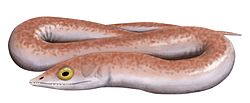| Barameda Temporal range: Tournasian ~ | |
|---|---|
 | |
| Life restoration | |
| Scientific classification | |
| Domain: | Eukaryota |
| Kingdom: | Animalia |
| Phylum: | Chordata |
| Clade: | Sarcopterygii |
| Clade: | Tetrapodomorpha |
| Class: | † Rhizodontida |
| Order: | † Rhizodontiformes |
| Family: | † Rhizodontidae |
| Genus: | † Barameda Long, 1989 |
| Species | |
| |
Barameda (Indigenous Australian language: "fish trap" [1] ) is a genus of rhizodont lobe-finned fishes which lived during the Tournaisian stage near the start of the Carboniferous period in Australia; fossils of the genus have been reported from the Snowy Plains Formation. [2] The largest member of this genus, Barameda decipiens, reached an estimated length of around 3–4 metres (9.8–13.1 ft), [3] while the smallest species, B. mitchelli is estimated to have had a length of about 35 centimetres (14 in). [4]





